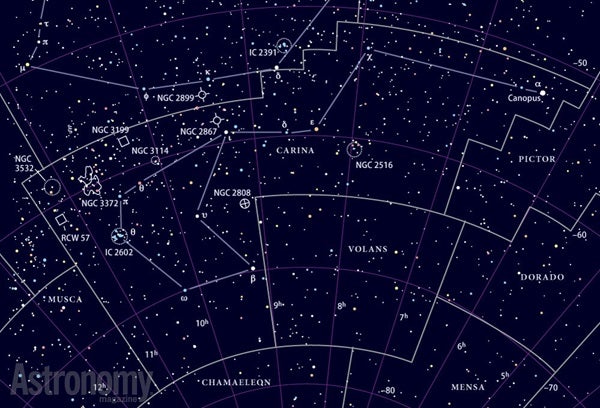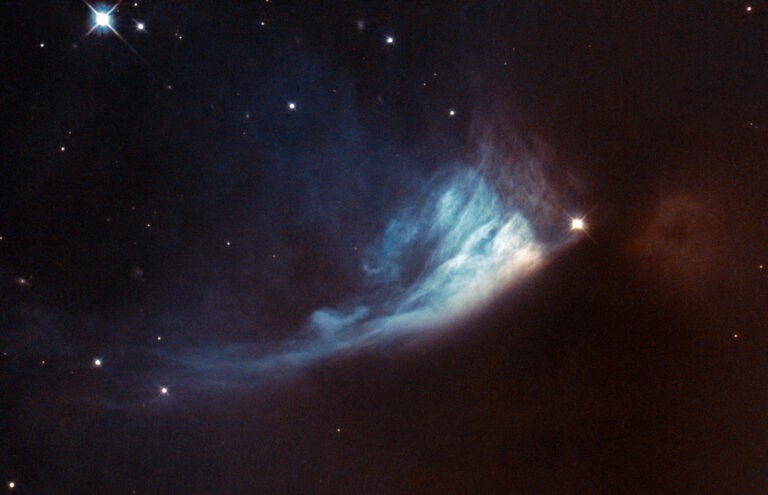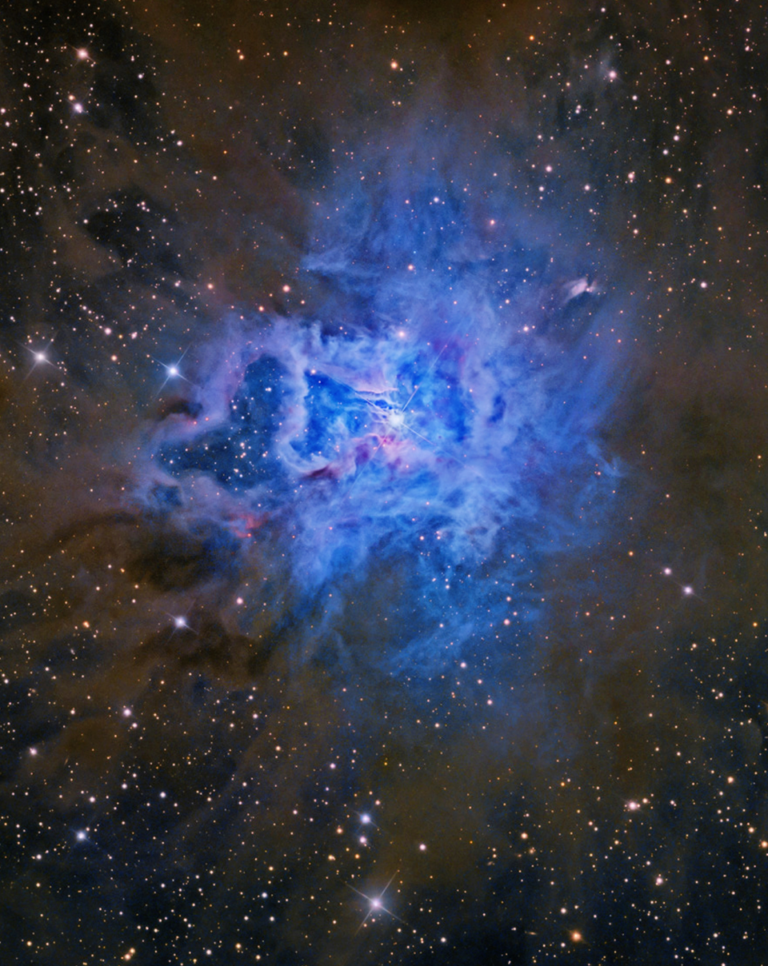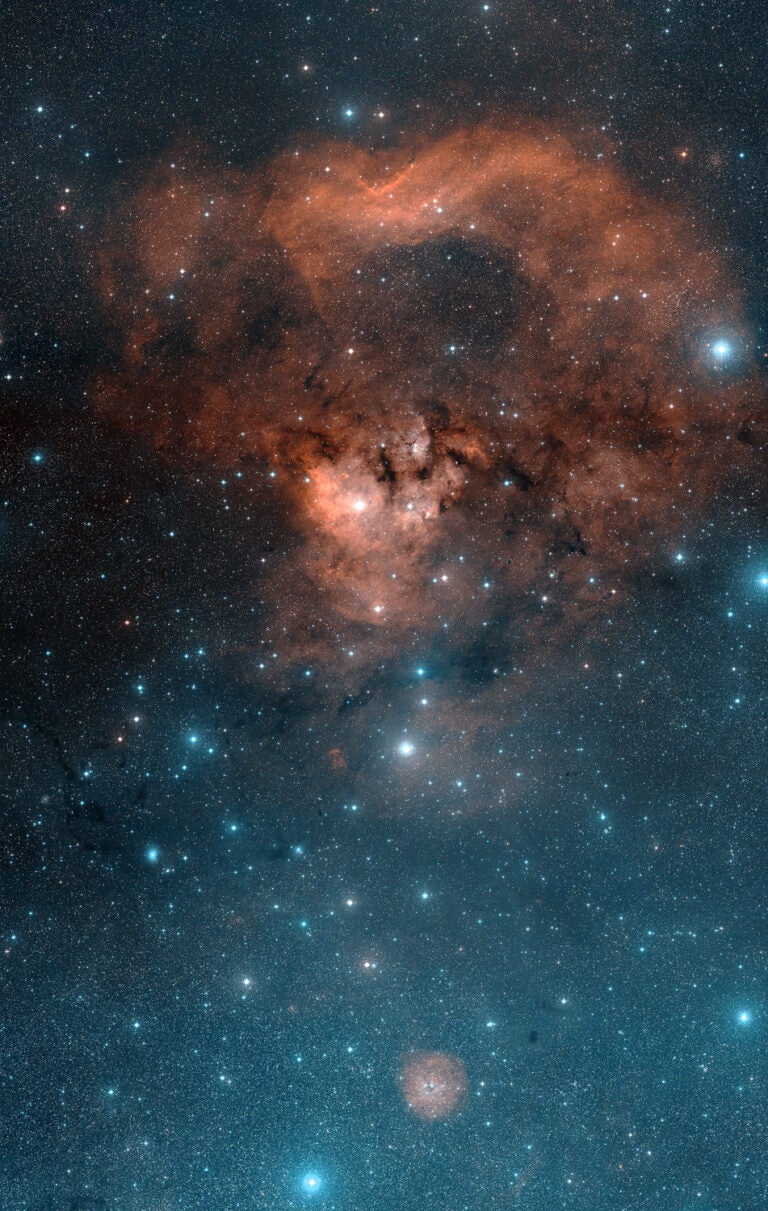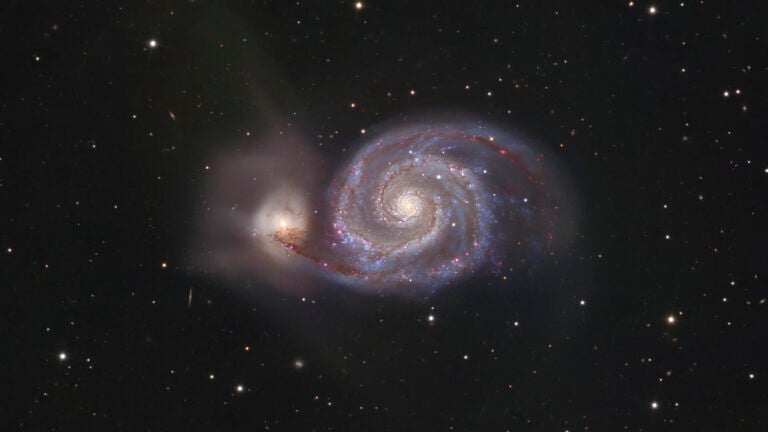Targets for April 21–28, 2016
Naked eyes: The Eta Carinae Nebula (NGC 3372)
Small telescope: Spiral galaxy M95
Large telescope: The Gamma Leonis Group
This week’s naked-eye object is for those of you who observe from latitudes south of 30° north. It’s the beautiful Eta Carinae Nebula, also known as NGC 3372. The sky’s most spectacular emission nebula lies in the southern constellation Carina the Keel.
Imagine a gas cloud nearly a light-year long expanding at 1.5 million mph (2.3 million km/h). Within the cloud sits a supermassive star radiating 5 million times the Sun’s energy. This scenario describes the Eta Carinae Nebula and its 6th-magnitude central star, Eta (η) Carinae.
Eta Carinae underwent a giant outburst about 150 years ago, when it became the second-brightest star in the sky. Although it released as much visible light as a supernova would, the star survived the explosion and produced a nebula with two polar lobes and a large, thin equatorial disk. Astronomers call the bi-lobed nebula the Homunculus, derived from the Latin for “little man.”
Observing the Eta Carinae Nebula offers a real treat for observers. At magnitude 3.0, the nebula is easily visible to the naked eye as the brightest spot in the southern Milky Way. This celestial wonder spans a whopping 2° and looks great through binoculars or any size telescope.
To find NGC 3372, look 4.5° due north of magnitude 2.7 Theta (θ) Carinae. Listeners to this podcast series will recall that I featured that star last week as the brightest in the Southern Pleiades.
At magnifications below 50x, the most prominent detail is a dark V-shaped rift slicing through the nebula’s center. Double the power, and you’ll see a scalloped edge against the bright background.
Look toward NGC 3372’s center for the Keyhole Nebula, a dark cloud with overlapping nebulosity. Double the magnification again, and find the yellowish region around Eta Carinae, which some amateurs have dubbed the Fried Egg. If the seeing is good, you may detect thin spokes of nebulosity that seem to emanate from the central star.
A great galaxy, bar none
This week’s small telescope target is barred spiral galaxy M95 in Leo. This terrific galaxy lies 3.6° northeast of magnitude 3.9 Rho (ρ) Leonis. It shines at magnitude 9.7 and measures 7.8′ by 4.6′.
Through a 4-inch telescope, M95 appears slightly elongated in a north-northeast to south-southwest orientation. The central region appears bright. Larger scopes show that a faint outer ring surrounds the core. The brightest parts of M95’s spiral arms make the ring.
Through a 16-inch or larger telescope at high magnification, you’ll immediately recognize this object’s bar, which stretches east-west from one side of the ring to the other.
M95 belongs to the M96 group of galaxies, sometimes called the Leo I Group, which lies 38 million light-years away. Don’t associate the name with the dwarf galaxy Leo I, which I also talked about in the last podcast. That object has nothing to do with this group.
Nine galaxies make up the Leo I Group. Along with M95 and magnitude 9.2 M96, magnitude 9.3 M105, magnitude 9.9 NGC 3384, and magnitude 10.4 NGC 3377 are the brightest members.
A “fab four” of galaxies
This week’s large telescope target is the Gamma Leonis group of galaxies in Leo. Astronomers also refer to it as the NGC 3190 group because that spiral galaxy is its largest member. NGC 3190 glows at magnitude 11.2 and measures 4.1′ by 1.6′.
You’ll find NGC 3190, and three other galaxies, 2° north-northwest of magnitude 2.0 Algieba (Gamma [γ] Leonis). Known by yet another name — Hickson 44 — this group is the brightest in Canadian astronomer Paul Hickson’s catalog of 100 compact galaxy groups. The most famous entry in his catalog probably is number 92, Stephan’s Quintet.
Let’s start with NGC 3190. It appears oval, three times as long as it is wide. Its central region is long and bright. Through an 11-inch telescope at a magnification of 250x, you’ll see the dust lane south of the nucleus. The lane is least apparent near the nucleus. It broadens in both directions as you look away from the center.
The brightest galaxy in Hickson 44 is the magnitude 10.8 elliptical galaxy NGC 3193. It lies a scant 6′ to the northeast of NGC 3190. Through an 11-inch scope, you’ll see that it contains a broad, evenly illuminated central region and a thin halo.
Next, look for the magnitude 12.0 barred spiral NGC 3185. It resides 11′ southwest of NGC 3190. Finally, the magnitude 12.9 spiral NGC 3187 sits 5′ to the west-northwest of NGC 3190. Even through a large telescope, you won’t pull much detail out of either of these two objects.
Expand your observing at Astronomy.com
The Sky this Week
Get a daily digest of celestial events coming soon to a sky near you.
Observing Basics
Find more guidance from Senior Editor Michael E. Bakich with his Observing Basics video series.

